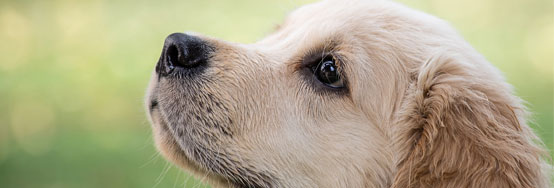Training Tips
What is the best way to train my puppy/dog?
Animal training should utilize positive reinforcement (e.g. giving treats, praise, toys) and negative punishment (e.g. removal of treats, attention, toys) to reduce undesirable behaviors. For example, when your dog greets you by jumping up, you remove your attention (negative punishment). When he/she sits or stands calmly, you reward your dog with praise or petting (positive reinforcement).
There are many programs that utilize these training techniques. “Work for a living” or “Nothing in life is free” are two examples. The principle components of these programs are:
- During training, any reward (attention, treats, food, play, toys) must first be “earned” by obeying simple commands (sit, stay, down). Your dog will learn faster if you feed kibble by hand for rewards vs. giving the food in a bowl. (Think 100 rewards vs. 1)
- Your dog should learn to automatically sit or lay down to get any reward. (Say “please!”)
- Remember that your dog can hear fine, so only say the command once or twice. If he/she doesn’t obey, remove the reward. Repeating commands only teaches your dog that it can ignore you and still get rewarded at the end.
- Rewards should be quickly and consistently given when desirable behaviors happen. Inconsistency causes confusion or miscommunication with your dog.
How about being “top dog”? I heard I should put my dog on its back and hold its muzzle closed.
Most undesirable behaviors in our pets are not related to priority access to resources (dominance); rather, they are due to accidental rewarding of undesirable behavior. When using physical force, exact timing and consistency are necessary in order to be effective. If the restraint is not strong enough, your dog will not stop the behavior unless you increase the intensity, which can cause physical injury or fear. Then if you dog faces a situation where it is extremely fearful, it may suddenly act with heightened aggression and with fewer warning signs, making it much more dangerous.
Why is punishment “bad”? It worked with my old dog.
Using punishment also doesn’t address the reason the bad behavior is occurring, which is intentional or unintentional reinforcement. You may punish bad behaviors some of the time while inadvertently rewarding these same behaviors at other times (e.g. you sometimes punish your dog for barking, but ignore it other times). In this way you can set up your pet to receive punishment. This inconsistency is confusing to your dog and can cause frustration or anxiety.
Punishment also fails to tell your pet what it should be performing instead. If you only use positive punishment (kneeing your dog when it jumps), it doesn’t learn what the proper method of greeting should be. And as our dogs love any kind of attention, this form of punishment may not be strong enough to prevent the behavior and you risk injuring your dog.
My dog is still having problems. What should I do?
There are numerous dog training facilities and programs available to clients. We recommend choosing a program that uses positive reinforcement and negative punishment techniques. If your dog is having aggressive issues, we recommend consulting a Veterinary Behaviorist to assess whether other treatments may be necessary.
On-line Resources:
American Veterinary Society of Animal Behavior: avsabonline.org/resources/position-statements
Dr. Sophia Yin’s Learn to Earn Program: drsophiayin.com/blog/entry/the-learn-to-earn-program

Contact Us

